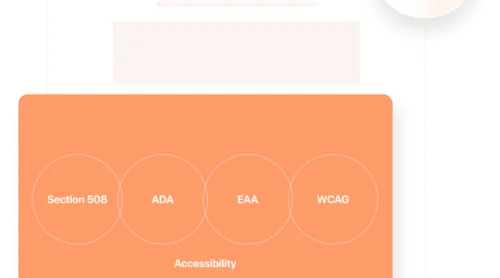What ADA Compliance Means for Small Businesses
ADA compliance for small businesses refers to adhering to the Americans with Disabilities Act, a civil rights law that ensures people with disabilities have equal access to goods, services, and digital spaces — including your business website. Although commonly associated with physical accessibility, the ADA also extends to the digital world, making it vital for small businesses to provide accessible online experiences.
For entrepreneurs navigating the digital space, understanding accessibility law for entrepreneurs isn’t optional — it’s essential. This means ensuring your content, navigation, forms, and media are usable for all users, including those relying on screen readers, keyboard navigation, or alternative input methods.
To comply with ADA standards, your website should meet the following core accessibility principles, often outlined in the Web Content Accessibility Guidelines (WCAG):
- Perceivable content. Information must be presented in a way that users can perceive, including text alternatives for images, captions for videos, and sufficient contrast for readability.
- Operable interface. Navigation must be usable by people with various input methods, such as keyboard-only users or those using assistive technologies.
- Understandable structure. Content should be clear and predictable, with consistent layout, intuitive forms, and helpful instructions to guide users through tasks.
- Robust compatibility. Your website should work reliably across different browsers, assistive devices, and future technologies that support accessibility.
Beyond legal obligations for online platforms, there’s a clear business case for ADA compliance. Inclusive design contributes to broader audience reach, better user experience, and a stronger brand image. Customers are more likely to trust and support businesses that accommodate everyone’s needs.
As digital access becomes a fundamental expectation, ADA compliance stands out not just as a requirement — but as an opportunity for small businesses to lead with empathy, clarity, and professionalism.
Who Needs to Follow ADA and Who Might Be Exempt
After understanding what ADA compliance entails, the next logical concern for many entrepreneurs is whether these rules apply to them. Small business owners often ask, “Does ADA apply to small businesses?” and “Are there any exceptions?” The reality is that most public-facing businesses, regardless of size, are expected to comply — especially in today’s digital-first landscape.
The Americans with Disabilities Act (ADA), passed in 1990, applies to both private employers and businesses open to the public. For employers, the ADA generally covers companies with 15 or more employees. For customer-facing businesses — such as restaurants, shops, healthcare clinics, law offices, and e-commerce brands — the law applies regardless of employee count if they qualify as “places of public accommodation”.
This includes not only physical spaces but also their digital extensions — namely, business websites that serve the public. As web accessibility lawsuits rise, the question isn’t just about legal exposure, but also about maintaining trust and usability for a wider customer base.
Common Questions Answered
Does ADA apply to all small businesses?
Are there ADA exemptions for small businesses?
Do digital-only businesses need to comply?
What if I didn’t know about these requirements?
Small business legal responsibilities go beyond just fulfilling ADA checkboxes — they represent a commitment to inclusivity and fairness. While ADA exemptions for small businesses do exist, they are narrow and often misinterpreted. A business that uses a basic compliance checklist to ensure key accessibility practices is better positioned for legal safety, customer satisfaction, and long-term credibility.
In short, don’t assume size shields you. As digital interactions grow, so do expectations. Investing in accessibility now — whether required or not — puts your business in a more competitive and socially responsible position.
Requirements Your Business Can’t Ignore
Once you’ve determined that your business falls under ADA regulations, it’s time to understand what compliance actually involves. ADA requirements for small businesses are designed to remove barriers that may prevent individuals with disabilities from accessing your services — either in a physical location or through your website.
It’s important to note that while core requirements apply across all sectors, certain rules may vary depending on your business model. For example, a boutique retail store has different physical accessibility needs than an online consultant offering services via video calls. However, both must still provide accessible experiences within their respective formats.
Below is a breakdown of key ADA compliance responsibilities that most small businesses should address:
| Requirement | Description | Applies to |
|---|---|---|
| Accessible Physical Spaces | Entrances, aisles, restrooms, and service counters must be usable by individuals with mobility impairments, including wheelchair users. | Brick-and-mortar businesses |
| Website Accessibility | Online content should follow WCAG guidelines, including screen reader compatibility, keyboard navigation, alt text, and sufficient color contrast. | All businesses with public-facing websites |
| Employee Training | Staff should be educated on how to accommodate customers with disabilities and how to maintain accessibility best practices. | Any business with customer interaction |
| Ongoing Monitoring | Stay informed about updates in ADA regulations and digital accessibility standards that may affect your legal responsibilities. | All business types |
| Record-Keeping | Maintain documentation of accessibility efforts, audits, and improvements to demonstrate compliance and intent in case of disputes. | All business types |
Don’t overlook your legal obligations for online platforms. A website that is visually attractive but functionally inaccessible to users with disabilities is not compliant. Features such as inaccessible menus, missing form labels, or videos without captions are common pitfalls that may result in legal complaints or user frustration.
Keeping your business aligned with ADA updates doesn’t require legal expertise — it just requires vigilance. Here are a few ways to stay informed:
- Subscribe to updates from the U.S. Department of Justice
- Follow the Web Accessibility Initiative for WCAG updates
- Join accessibility newsletters or forums focused on small business legal trends
- Monitor trusted compliance software providers who offer news alerts and audits
By staying proactive, you protect your business from lawsuits, strengthen public trust, and create a more welcoming space — both online and off — for everyone.
Why Your Website Accessibility Matters
When most business owners think of ADA compliance, they picture ramps, signage, and service counters. But in today’s digital-first world, your business website is just as important as your physical location. For small businesses, ignoring online accessibility can be a costly mistake — both legally and reputationally.
The ADA doesn’t explicitly mention websites, but courts and regulatory bodies have increasingly interpreted it to include digital spaces. This means that ADA website compliance for small business owners is now a pressing issue — not just a best practice.
| Why Your Website Is Covered | What Happens If It’s Not Accessible |
|---|---|
| Public access point: Your website is a key interface where customers browse products, read content, and contact your business — it’s considered a public-facing service. | ADA lawsuits and fines: Inaccessible websites may violate Title III of the ADA, leading to legal complaints, fines, or forced settlements — often without warning. |
| Integration with physical services: If your business operates a physical location, your website often acts as an extension of it, providing directions, appointment scheduling, or product previews. | Frustrated users and lost business: Visitors who can’t navigate your website due to visual, motor, or cognitive limitations are likely to leave — and not return. |
| Legal classification: Courts increasingly interpret business websites as “places of public accommodation”, especially if they facilitate commercial transactions or public interaction. | Brand and trust erosion: Customers today expect ethical business practices. A lack of accessibility may be viewed as exclusionary or negligent, damaging your credibility. |
Even if your business is only online, you’re not off the hook. U.S. courts have ruled that digital-only businesses must still follow digital accessibility standards. Whether you’re selling products through an e-commerce platform or offering consultation services via a booking form, your website needs to be navigable and usable for people with disabilities.
Many small business owners assume ADA lawsuits only happen to large corporations. In reality, hundreds of small businesses are served with demand letters each year — often due to easily fixable accessibility issues. These lawsuits can result in thousands of dollars in settlements or legal fees, even for unintentional violations.
That’s why ADA compliance for small businesses must include digital considerations. Accessibility is no longer a niche concern — it’s a foundational part of building trust, serving all users fairly, and staying competitive in an increasingly digital economy.
Steps to Make Your Website ADA Compliant
Now that you understand why accessibility matters, the next step is putting it into action. While it may seem overwhelming at first, there are clear and manageable steps you can take. This ADA compliance guide for businesses breaks down the process into practical actions to help you get started without delay.
Whether you’re building a new website or improving an existing one, following this roadmap will move you closer to full accessibility and lower your risk of accessibility lawsuits.
- Audit your website:
Start with a thorough accessibility audit to identify barriers for users with disabilities. Use automated tools like WAVE or Axe for a quick overview, but always follow up with manual reviews or expert analysis to catch issues automated checkers can miss. - Follow WCAG guidelines:
Use the Web Content Accessibility Guidelines (WCAG) as your standard. These provide clear instructions for making text readable, media accessible, and interactions intuitive for all users. - Fix high-impact issues first:
Focus on addressing the most common and disruptive accessibility failures — such as missing alt text, poor color contrast, broken keyboard navigation, or forms that don’t support screen readers. - Implement semantic HTML:
Use HTML elements properly — like <label> tags for form inputs, headings in logical order, and ARIA roles where needed — to improve compatibility with assistive technologies and screen readers. - Test with real users:
If possible, conduct usability tests with individuals who rely on assistive technology. Their feedback offers critical real-world insights that even professional audits may overlook. - Document your progress:
Keep a record of your updates, testing, and changes. Documentation shows good-faith effort if legal concerns arise and provides structure for maintaining long-term accessibility.
While some improvements can be made internally, others may require a professional accessibility audit or assistance from web developers — especially if your platform uses custom code or third-party tools.
By following these steps and staying committed to ongoing improvement, you’ll make your website not only legally compliant but also more welcoming and usable for everyone.
Elfsight ADA Compliance Widget
If you’re looking for a fast, affordable, and no-code solution, Elfsight offers an ADA Compliance Widget that can be installed in minutes. This tool enables users to adjust text size, contrast, spacing, and navigation modes — all while aligning your website with digital accessibility standards. It’s ideal for small businesses who want to make meaningful accessibility improvements without hiring developers.
Here’s a breakdown of how to activate and configure the widget using Elfsight’s platform:
- Select a Starting Template. Go to the Elfsight editor and select a template. Click “Continue with this template” to start personalizing your widget.
- Run an Accessibility Review. Enter your website URL into the scanner and click “Check”. Elfsight will use Lighthouse technology to analyze compliance issues and generate an accessibility performance report.
- Adjust Settings and Styling. Under the “Settings” section, define your language preferences, reposition the widget, set how long settings are remembered, and apply your own CSS or JS for further customization.
- Install the Widget on Your Website. Click “Add to website for free” to generate your embed code. Paste it before the </body> tag in your website’s backend. Save and publish the update to enable full functionality across your website.
Once active, the widget helps you deliver a more accessible and compliant experience, tailored to meet the expectations of ADA standards and user accessibility needs. This widget offers a quick and reliable way to make your website inclusive — perfect for businesses without access to technical resources.
Enchance usability to all — build your own widget now!
Tools to Help You Meet ADA Standards
While some small business owners prefer to handle accessibility updates internally, many turn to external support — especially when time, budget, or expertise is limited. That’s where ADA website compliance companies come in. These partners offer tools, audits, and ongoing support that simplify the process of making your website accessible and legally compliant.
AccessiBe
A fully automated AI-based solution, AccessiBe scans and modifies your website to meet accessibility standards. It includes an interface for users to customize their experience and an AI-powered background process that adjusts content and structure to align with WCAG requirements. Ideal for fast-moving teams with limited technical support.
AudioEye
AudioEye combines automated scanning with human verification, offering both an accessibility toolbar and detailed remediation services. They also provide certification and litigation support, making them a stronger fit for businesses at higher legal risk or requiring enterprise-level validation.
UserWay
UserWay offers a widget-based solution similar to Elfsight but with optional advanced services, including audits and consulting. The widget provides on-screen tools like text resizing, color adjustment, and keyboard navigation, supporting a more inclusive browsing experience.
Using third-party tools doesn’t absolve you of responsibility, but it can significantly reduce the burden of achieving and maintaining compliance. Whether you choose a widget or a full-service agency, make sure the partner follows up-to-date WCAG and ADA best practices.
In the next section, we’ll wrap up the key takeaways and help you decide what your first step should be in making your website fully accessible.
Conclusion
Whether you’ve chosen to start with a quick-install tool like the Elfsight ADA compliance widget or you’re working with a full-service provider, one thing is clear: accessibility compliance for businesses websites is not just a legal necessity — it’s a strategic advantage. Accessibility improvements help you meet online accessibility regulations, reduce your legal exposure, and open your business to a broader audience that values inclusivity and ethical practices.
Moving forward, the best approach is to take consistent, manageable steps using a compliance checklist as your guide. Prioritize changes that improve usability for everyone, not just users with disabilities. Remember, ADA compliance is not a one-time fix — it’s an ongoing commitment to equal access, better user experience, and long-term business growth. By embracing accessibility now, you’re investing in a future-proof foundation that sets your small business apart for the right reasons.







